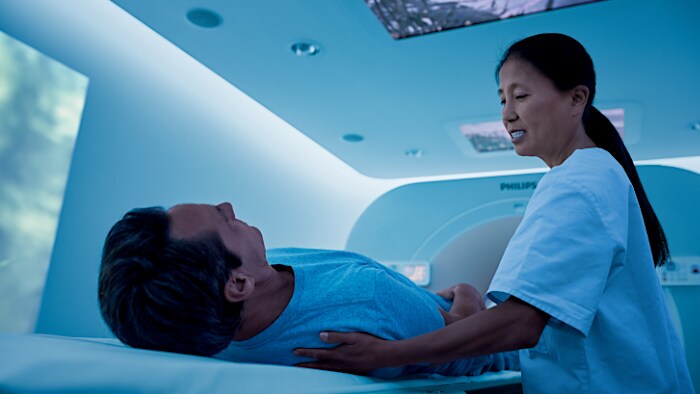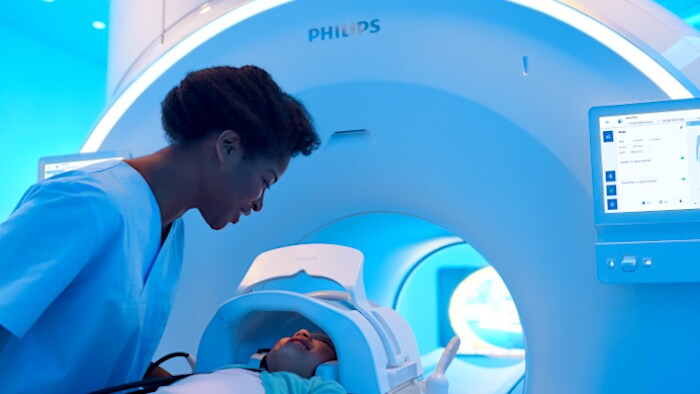Podcast: Fear & anxiety in imaging: Psychology meets technology
Stress is not just an emotional response to uncomfortable situations: it is a physical reaction with measurable consequences. In imaging, patient anxiety about diagnostic procedures may impact the accuracy and quality of exams, skewing or delaying diagnosis and treatment. Fortunately, we know a lot about how these factors influence patient responses to imaging – and how we can help mitigate them. In this podcast we talk to Boris de Ruyter, a psychologist whose team has spent decades studying the impact of technology on people and Mary Beth Resimius, expert in people-centered imaging solutions. Listen in to learn about their research and how it can guide more patient-centered imaging.
About the speakers

Prof. Boris de Ruyter Principal Scientist Philips Research Europe
Boris de Ruyter graduated as an Experimental Psychologist from the University of Ghent in Belgium, after which he worked as a Research Assistant at the University of Antwerp. In 1995 he joined Philips Research in Eindhoven, The Netherlands, where he worked first as Senior Scientist and since 2006 as Principal Scientist. Beyond his position at Philips Research, Boris is a Professor, by special appointment, of Human Interactions with Intelligent Systems at the Radboud University in Nijmegen, The Netherlands. His research focuses on the psychological impact of technological applications on people.

Mary Beth Resimius Philips Healthcare Experience Solutions
Business Lead
Ms. Resimius is responsible for leading Philips’ Healthcare Experience Solutions team in North America. Mary Beth and her team are responsible for developing and delivering strategic healthcare experience consulting services and solutions. Her corporate role at Philips is enriched by 25 years of previous leadership in healthcare administration, strategic development, and experience consulting across clinical care areas including ob/gyn and reproductive endocrinology, orthopaedics, neurology, primary care, and cardiology. Prior to Philips, she served as director of information services and strategic partnerships for The Wisconsin Heart Hospital and senior director within the Corporate Information Services division of Ascension Health.
Related links
Effects of lighting ambiences and music and the concept of self-regulation Anastos, J.P. (2007). The Ambient Experience in pediatric radiology, Journal of Radiology Nursing, 26(2), 50-55. Cajochen, C. (2007). Alerting effects of light, Sleep Medicine Reviews, 11(6), 453–64. De Ruyter, B. Presentation at Stanford University on the psychological effects of light. January 13, 2014. Durak, A., Nilgün, C.O., Cengiz, Y., Dilek, G. and Yusuf, G. (2007), Impact of lighting arrangements and illuminances on different impressions of a room, Building and Environment, 42 (October), 3476-482. Hamel, W.J. (2001). The effects of music intervention on anxiety in the patient waiting for cardiac catheterization, Intensive and Critical Care Nursing, 17(5), 279-285. Knez, I. (2001). Effects of colour of light on nonvisual psychological processes, Journal of Environmental Psychology, 21(2), 201–208. Lockley, S. W., Evans, E. E., Scheer, F. A., Brainard, G. C., Czeisler, C. A., & Aeschbach, D. (2006). Short-wavelength sensitivity for the direct effects of light on alertness, vigilance, and the waking electroencephalogram in humans, Sleep, 29, 161–168. Manav, B. (2007). An experimental study on the appraisal of the visual environment at offices in relation to colour temperature and illuminance, Building and Environment, 42 (2), 979-983. Partonen, T. & Lonnqvist, J. (2000). Bright light improves vitality and alleviates distress in healthy people, Journal of Affective disorders, 57, 55-61. Tice, D. M., Baumeister, R. F., Shmueli, D., & Muraven, M. (2007). Restoring the self: Positive affect helps improve self-regulation following ego depletion, Journal of Experimental Social Psychology, 43(3), 379–384.
Impact of stress and patient motion on MR imaging Andre, J. & Johanssan, K. (2016). Relaxed patients, reduced motion, improved productivity. FieldStrength MRI Magazine article. Andre J., Bresnahan B.W., Mossa-Basha, M., et al. (2015). Toward quantifying the prevalence, severity, and cost associated with patient motion during clinical MR examinations. J Am Coll Radiol. 12:689-95. Nèmery, M.C. & Mortensen, J.B. (2015). Patient comfort leads to first-time-right imaging. FieldStrength MRI Magazine article.
Impact of patient-centered PET/CT environment intervention Vogel, W.V., Valdés Olmos, R.A., Tijs, T.J., Gillies, M.F., van Elswijk, G., & Vogt, J. (2012). Intervention to lower anxiety of 18F-FDG PET/CT patients by use of audiovisual imagery during the uptake phase before imaging. J. Nucl. Med. Technol. 40:92-98.

Learn about Ambient Experience solutions for patient-centered imaging
Can improving the patient experience in MR imaging boost productivity?





